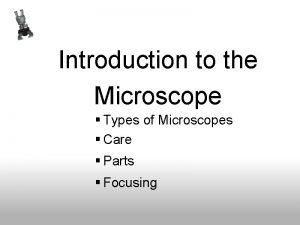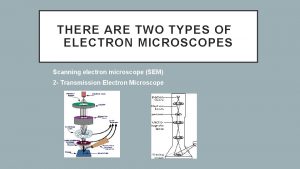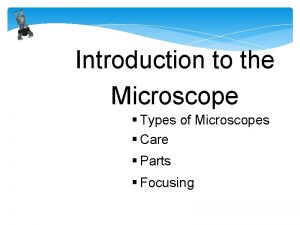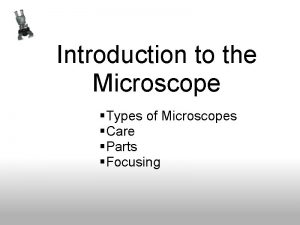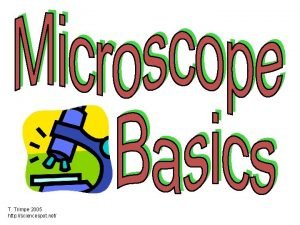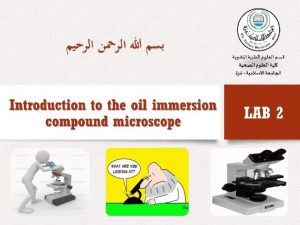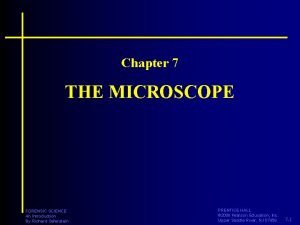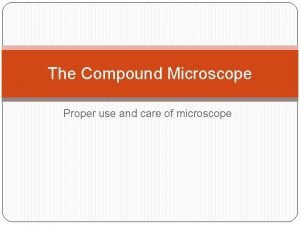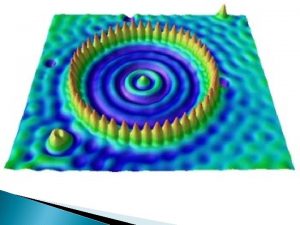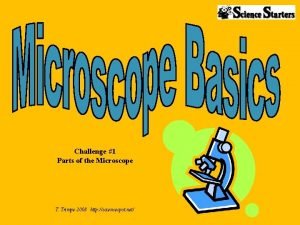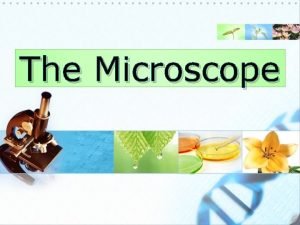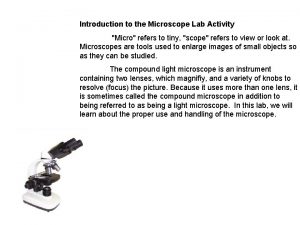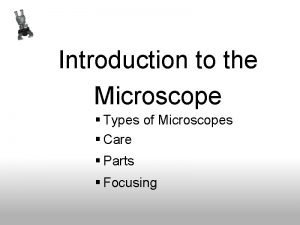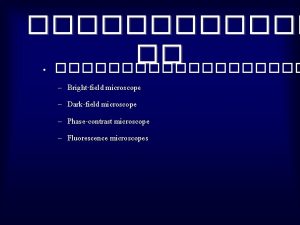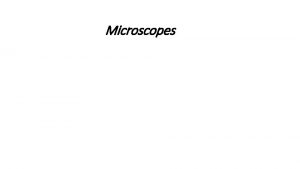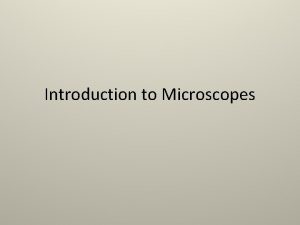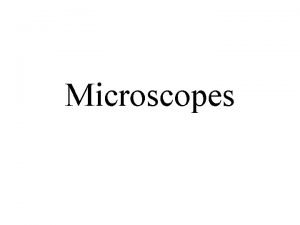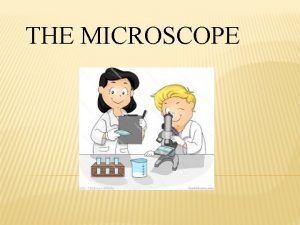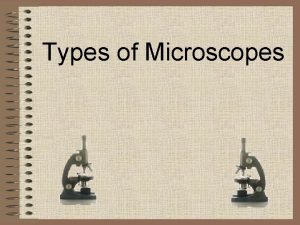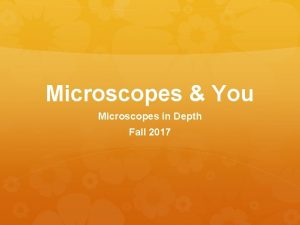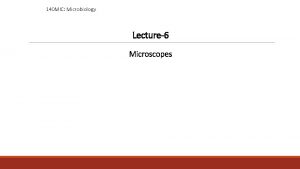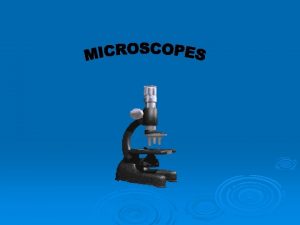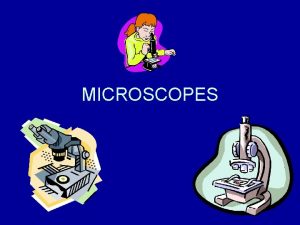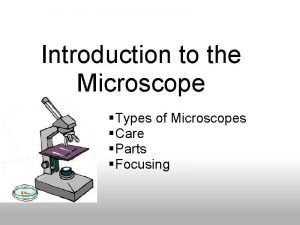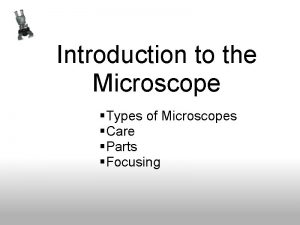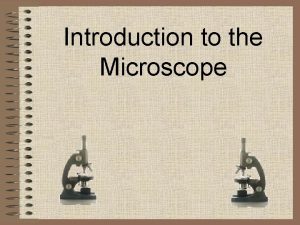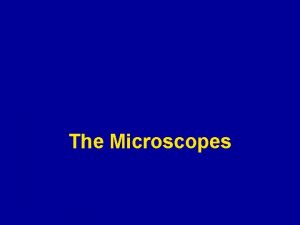Introduction to the Microscope Types of Microscopes Care





















- Slides: 21

Introduction to the Microscope § Types of Microscopes § Care § Parts § Focusing

Uses & Background • Instrument used to view objects that are too small for the naked eye. – Etymology: • Micro- small/minute (ie microchip, microbiology) • Scope- to see (ie telescope, periscope)

Scale Copyright © The Mc. Graw -Hill Companies, Inc. Permission required for 3

Copyright © The Mc. Graw-Hill Companies, Inc. Permission required for reproduction or display. Uses/Background • Antony van Leeuwenhoek (1632 -1723) – first person to use a microscope to observe and describe microorganisms accurately – Coined the term “cell” 4 Leeuwenhoek’s notes & records re: microsopy

Types of Microscopes • Light Microscope –the models found in most schools, use compound lenses to magnify objects. The lenses bend or refract light to make the object beneath them appear closer. - Common magnifications: 40 x, 100 x, 400 x - Oil Immersion lenses can improve quality of focus and magnification

• Dissecting Stereoscope/ Dissecting Stereoscopic Microscope –This microscope allows for binocular (two eyes) viewing of larger and live specimens. –Usually magnifies 10 x to 20 x –Can be used for thicker specimens –Creates a 3 D view of specimen

• Scanning Electron Microscope –allows scientists to view a universe too small to be seen with a light microscope. –SEMs do not use light waves; they use electrons (e-) to magnify objects up to 2, 000 x!!! –SEM creates a 3 D view of specimen, but cannot view living specimens (process kills them)

• Transmission Electron Microscope - also uses electrons, but instead of scanning the surface (as with SEM's) - electrons are passed through very thin specimens. -TEM = "thin"

TEM of a cell, notice you see the inside of the cell and not the surface.

Microscope Resources Virtual Microscopes (Phase Contrast, Fluorescence, TEM, STM) at http: //nobelprize. org/educational/physics/microscopes/1. html Nanoworld Image Gallery Microworld Images

Types of Illumination in Microscopes How light passes through a specimen changes the view of the specimen, making some parts more distinct.

Figure 4 Ba

Figure 4 Bb

Figure 4 Bc

Figure 4 Bd

Figure 4 Be

Body Tube Revolving Nosepiece Objective Lens Stage Clips Diaphragm Light Eyepiece/ Ocular lens (10 x) Arm Stage Coarse Focus Fine Focus Base

Magnification Your microscope has 3(or 4) magnifications: Scanning (not to be confused w/ “Low”), Low & High. Each objective is engraved with its magnification. The ocular lens (eyepiece) also has a magnification. The total magnification is the ocular magnification multiplied by the objective magnification. (ie 10 x x 40 x = 400 x)

Practice Labeling the Parts a Microscope

Quiz Over the Microscope 1. When focusing a specimen, you should always start with the __________ objective. 2. When using the high power objective, only the ______ knob should be used. 3. The type of microscope used in most science classes is the _________ microscope 4. Stains can be drawn under the slide (and over a specimen) by using a ___________ 5. What part of the microscope can adjust the amount of light that hits the slide? _______________

6. You should carry the microscope by the ____ and the _____. 7. The objectives are attached to what part of the microscope (it can be rotated to click the lenses into place): ________________ 8. You should always store you microscope with the ________ objective in place. 9. A microscope has an ocular objective of 10 x and a high power objective of 50 x. What is this microscope's total magnification? ______ 10. SEM is an abbreviation for ____________ _________
 Three types of microscope
Three types of microscope Types of electron microscope
Types of electron microscope Types of microscopes
Types of microscopes Types of microscopes
Types of microscopes T. trimpe 2006 http://sciencespot.net/
T. trimpe 2006 http://sciencespot.net/ What is purpose of microscope
What is purpose of microscope Forensic science microscopes
Forensic science microscopes Colors seen in images made from electron microscopes are
Colors seen in images made from electron microscopes are Uses of compound microscope
Uses of compound microscope Electron microscopes main idea
Electron microscopes main idea Primary secondary tertiary care definition
Primary secondary tertiary care definition Difference between light microscope and electron microscope
Difference between light microscope and electron microscope Microscope mania compound light microscope
Microscope mania compound light microscope Introduction about microscope
Introduction about microscope Introduction to the microscope lab activity
Introduction to the microscope lab activity Microscope introduction
Microscope introduction Hát kết hợp bộ gõ cơ thể
Hát kết hợp bộ gõ cơ thể Frameset trong html5
Frameset trong html5 Bổ thể
Bổ thể Tỉ lệ cơ thể trẻ em
Tỉ lệ cơ thể trẻ em Voi kéo gỗ như thế nào
Voi kéo gỗ như thế nào Glasgow thang điểm
Glasgow thang điểm
